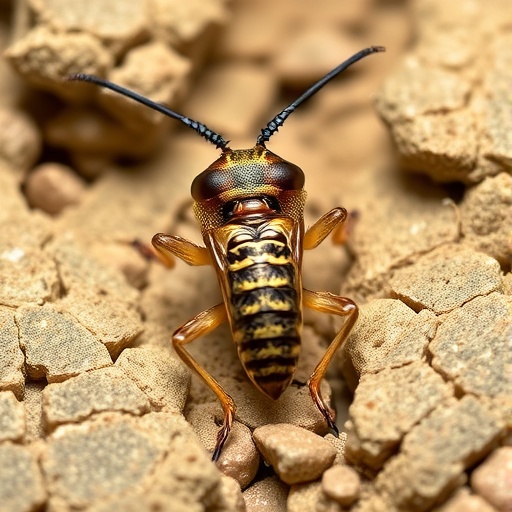A groundbreaking study published in the Environmental Science and Pollution Research journal has unveiled significant findings regarding the impact of zinc chromium oxide nanocompounds on the midgut of the desert locust, Schistocerca gregaria. This research, conducted by Hashem, Sopaih, and Mostafa, delves into the histological and ultrastructural alterations that these nanocompounds induce, offering new insights into the intersection of environmental science and entomology. The implications of these findings are vast, not only for understanding locust biology but also for addressing the broader issues of nanomaterial toxicity and its impact on ecosystems.
The desert locust, a species known for its devastating swarms that can obliterate crops and threaten food security, has become a focal point for researchers studying the effects of various environmental pollutants. In their experiment, the researchers administered zinc chromium oxide nanocompounds to the locusts and meticulously observed the resulting changes in the midgut structure. This examination employed advanced histological techniques combined with rigorous ultrastructural analysis, showcasing the complexity of biological responses to nanoscale materials.
Nanotechnology applications have proliferated in recent decades, leading to the increased use of metal oxides like zinc and chromium in various industries. However, the release of these nanomaterials into the environment poses significant questions regarding their safety and environmental consequences. The researchers’ innovative approach involved carefully controlled exposure of the desert locusts to zinc chromium oxide, enabling them to monitor the histological changes over a determined period.
Histological examination revealed striking alterations in the cellular architecture of the midgut, which serves as a critical digestive component for these phytophagous insects. The midgut is responsible for nutrient absorption and digestion, making it essential for the locust’s survival and reproduction. The researchers documented the degradation of epithelial cells, which are vital for maintaining digestive functions. This information is paramount, as prolonged exposure could have repercussions on the locusts’ overall health and population dynamics.
The ultrastructural observations offered a more granular view of the cellular damage inflicted by the nanocompounds. The researchers identified alterations in the microvilli, tiny projections that enhance the surface area for nutrient absorption. A reduction in the length and density of these structures indicated impaired digestive efficiency, which could significantly threaten the locusts’ nutritional intake. As locusts continue to feed on vegetation, their ability to absorb nutrients is paramount, and any reduction can have cascading effects.
Moreover, this study highlighted the inflammatory responses triggered by the introduction of zinc chromium oxide nanocompounds, which manifested as increased hemocyte activity. Hemocytes are an essential part of the immune system in insects, playing a critical role in responding to pathogens and foreign substances. The researchers observed that exposure to the nanocompounds resulted in heightened hemocyte proliferation, suggesting an immune response to the perceived threat. This dynamic indicates that the desert locusts’ immune system is engaged in a fight against potential cytotoxic agents, which could affect their survivability under stress.
As researchers broaden their understanding of the impacts of nanotechnology, it becomes increasingly crucial to examine how these materials affect not just target organisms but also the larger ecosystem. The findings from this study of S. gregaria amplify concerns over biopersistence and bioaccumulation of nanoparticles in food webs. If these pollutants are detrimental to locusts, it raises alarms about their effects on other species, potentially leading to ecosystem imbalances.
One of the more pressing implications of the research lies in its potential application for pest control strategies in agriculture. If zinc chromium oxide nanocompounds can effectively disrupt the health and viability of locust populations, farmers may find new allies in their battle against these voracious pests. However, the dual-edged sword of such chemical applications necessitates comprehensive risk assessments to prevent unintended ecological consequences.
Moreover, this research galvanizes the call for more stringent regulations concerning the use of nanomaterials in agricultural contexts. As industries continue to adopt nanotechnology for its beneficial properties, it is vital to assess the environmental impacts systematically. The study underscores the urgency of investigating how emerging technologies can be employed sustainably and responsibly.
The paradigm of environmental science is shifting, as studies like Hashem et al.’s illustrate the intricate relationships between nanotechnology, insect physiology, and environmental health. The thorough exploration of the histological and ultrastructural changes in locusts opens up new avenues for research, prompting further investigations into the effects of various nanomaterials on diverse taxa.
To encapsulate, the original contributions of this study provide a cautionary tale about integrating nanotechnology into ecosystems. The evidence presented outlines specific physiological impacts on an important and often problematic species, showcasing the need for ongoing scholarship in this arena. Environmental scientists, agricultural technologists, and policymakers will benefit from reflecting on such research to inform practices that safeguard biodiversity while embracing innovation.
In conclusion, the investigation into the effects of zinc chromium oxide nanocompounds on Schistocerca gregaria lays the groundwork for future studies targeting the environmental threats posed by industrial pollutants. The results underscore the interconnectivity of ecological health, pest management, and nanotechnology, prompting the scientific community to consider the long-term fates of locusts and other species in a nano-infused world.
As the world continues to grapple with the challenges posed by climate change and invasive species, studies like this one remind us of the delicate balance that sustains life on Earth. The insights garnered can foster dialogues about improving environmental practices to ensure a sustainable future for ecosystems and agriculture alike.
Subject of Research: Impact of zinc chromium oxide nanocompounds on the midgut of desert locusts.
Article Title: Histological and ultrastructural changes in the mid gut of desert locust, Schistocerca gregaria (Orthoptera: Acrididae) treated with zinc chromium oxide nanocompound.
Article References:
Hashem, F.M., Sopaih, M. & Mostafa, W.A. Histological and ultrastructural changes in the mid gut of desert locust, Schistocerca gregaria (Orthoptera: Acrididae) treated with zinc chromium oxide nanocomb. Environ Sci Pollut Res (2025). https://doi.org/10.1007/s11356-025-37113-9
Image Credits: AI Generated
DOI: https://doi.org/10.1007/s11356-025-37113-9
Keywords: zinc chromium oxide, nanocompounds, desert locust, histological changes, ecological impact, pest management, environmental science.




